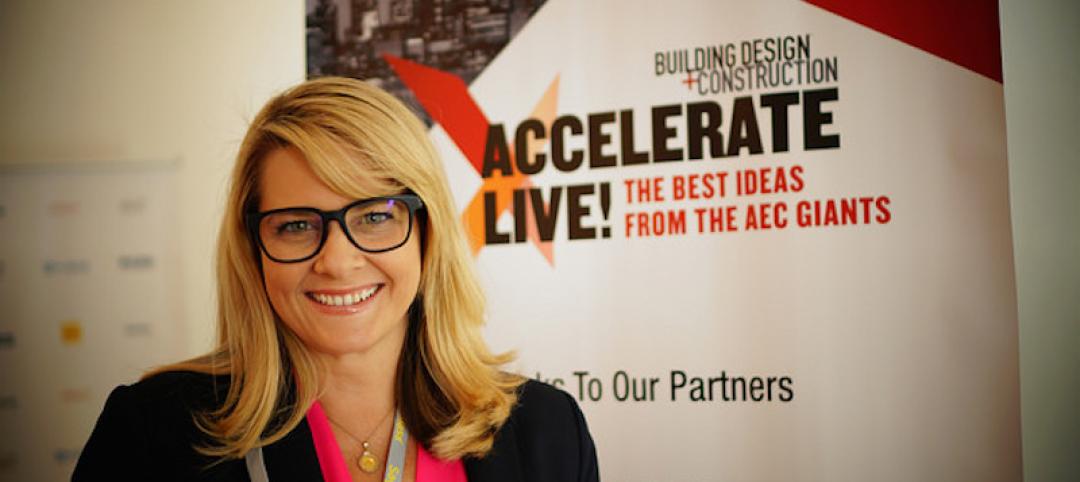BIMForum recently held their spring conference in San Diego with the theme BIM – Transforming Deliverables. With a topic like this, I just had to attend and see what I could uncover. Armed with a camera crew (and permission from the event organizers), I set out to conduct off-stage interviews, bringing these important conversations beyond the conference to you.
To kick off this interview series, I’ll start by sharing my sit-down interview with two of the speakers from the session BIM Won’t Work as a Deliverable, Will It? This was one of my must-see sessions, primarily because it was a multi-perspective panel aimed at uncovering the barriers project partners face today. After all, in order to better define changes required for success tomorrow, we must take an honest look at our current state. Moderated by Dace Campbell, an Autodesk Customer Success Manager, the panel consisted of an architect, a contractor and an attorney. They were Josh Emig of Perkins + Will, Ricardo Khan, Director of Integrated Construction for M.A. Mortenson Company, and Lindsay Pflugrath, an attorney with Skellenger Bender.
I sat down with Campbell and Khan to ask them about their approach and better understand the value proposition of BIM for each party represented. Campbell, an architect and former contractor turned technology partner, felt multiple perspectives were required in order to paint an accurate picture of the complexity surrounding this challenge. He believes we are moving towards a state in which BIM can be a deliverable with the Right of Reliance. He further believes the benefits of doing so outweigh the risk. Khan echoed that sentiment, highlighting how this affects those downstream, from fabricators to constructors and ultimately affects what is delivered to the owner. Both agreed technology is only one piece of the puzzle; people, culture and process are other factors to be considered.
Speaking from the contractor’s perspective, Khan believes his role reflects what a lot of other contractors have experienced – they’ve evolved into integrators. Their new focus is in finding ways to build collaborative approaches with design partners in order to provide the best output for the owner. He views the contractor as the “final touch point” in the process, adding, “It’s an exciting time for us.”
And I couldn’t agree more. I personally find the contractor’s transformation to integrator to be one of the key pivots for the industry. When I asked Khan how he sees this transformation affecting his trade partners, he replied, “For our trade partners, we try to find the best information that they need to be able to execute their work, with zero rework, or first-time quality. And to be the safest they can. The model is just one of these extra data points we can provide them. The 2D environment is great; unfortunately, it’s still contractually obligated for us to build off of that, but the model becomes this communication vehicle, which allows us to truly eliminate interpretation. So that integrator role plays a part in communication with a visual context.”
Campbell agreed, stating that it even came up during the panel discussion. “It’s paramount if we’re going to be moving towards a situation where the model is something you can rely on as a deliverable, that every key stakeholder has uninhibited access to that data; you can’t have BIM illiteracy out in the field. It’s imperative that everybody, just as well as they can read a drawing or a spec, has the same literacy to read a model and have access to that. Whether they are the front end designer, an owner, downstream subcontractor or FM, it’s shifting the entire industry and building a model industry.”
It was at this point I agreed and added that in order for this to become a reality, it puts more pressure on technology companies to come up with solutions that are easy to use and take out the complexity for the end user. I believe this is one of the factors that make this challenge so complex. In order to affect people, culture and process, we need technologies that bridge the access and fluency gaps for all within the 3D realm.
Our conversation continued as we discussed the “BIM curve” and key takeaways from the conference. We ended our discussion on the idea that in order for any of this to become a reality, we all must see BIM as a workflow. It shouldn’t be defined by technology, but rather, technology should be an enabler of these workflows.
I’d like to thank each of the speakers who sat down with me and shared their ideas and perspectives. Special thank you to the organizers of BIMForum for allowing me conduct these interviews and share the full conference sessions with you.
For more insights or to hear the full interview, watch the embedded video. If you’d like to see this session in its entirety, click here to watch on BIMForum’s YouTube Channel.
More from Author
Sasha Reed | Dec 15, 2017
Future vs. current state of construction innovation: How will we make the leap?
Looking beyond today’s constraints to the possibility of what “could be” is a key characteristic of those defining and delivering innovation to design and building firms across the globe.
Sasha Reed | Sep 19, 2017
BIM vs VDC…how the US and the UK differ in approaching digital project delivery
In this four-part series, Bluebeam VP Sasha Reed sat down with industry experts to examine the need for defining and understanding digital workflows and data management throughout the design and construction project lifecycle.
Sasha Reed | Jul 19, 2017
Introducing StrXur by Bluebeam
Our goal is to present unique perspectives you may not be able to find anywhere else.
Sasha Reed | Jul 13, 2017
Defining the future by mastering the art of change
From my perspective, what separates organizations thriving in the digital revolution from those who are not boils down to one thing: leadership.
Sasha Reed | Mar 15, 2017
Incentivizing change: Show me the money
Who is succeeding, and on what terms? And what will it take for everyone to experience the benefits of that success?
Sasha Reed | Oct 4, 2016
The talent shortage: Will the training the AEC industry desperately needs arrive in time?
As the construction industry bounces back from the Great Recession, an entirely new class of tech-savvy construction professionals has been created, and the supply of these highly skilled, tech-proficient pros has been quickly exhausted.
Sasha Reed | Jul 11, 2016
Construction Disruption at AECX: Technology, hackathons and the promise of change in LA
The lead up to AECX featured a discussion providing insight into the current state of the AEC technological revolution by exploring opportunities, challenges and choices AEC pros face.
Sasha Reed | Jun 23, 2016
Implementing Change: The Five Biggest Mistakes to Avoid
Two truths from the jobsite: 1) The best part about uncovering a problem is discovering its solution, and 2) The worst part about discovering the solution is implementing it.
Sasha Reed | Jun 9, 2016
With all these sharks in the water… (No Predictions Here...Part 2)
Rather than fighting to control the proliferation of apps, perhaps we should be training our eyes to look for signs of long-term viability among all the fins in the water
















